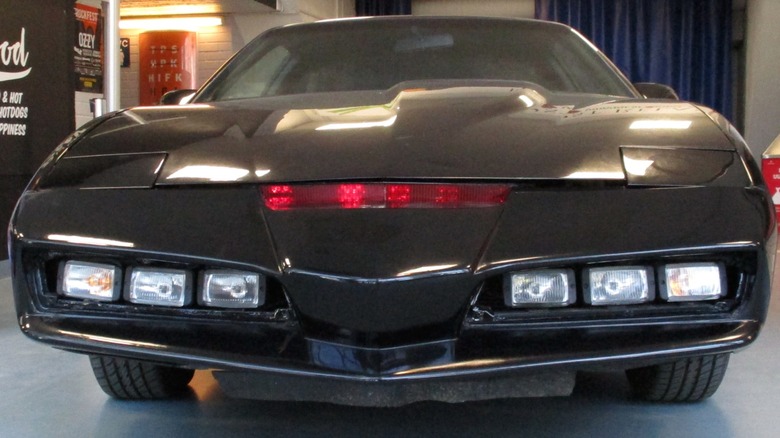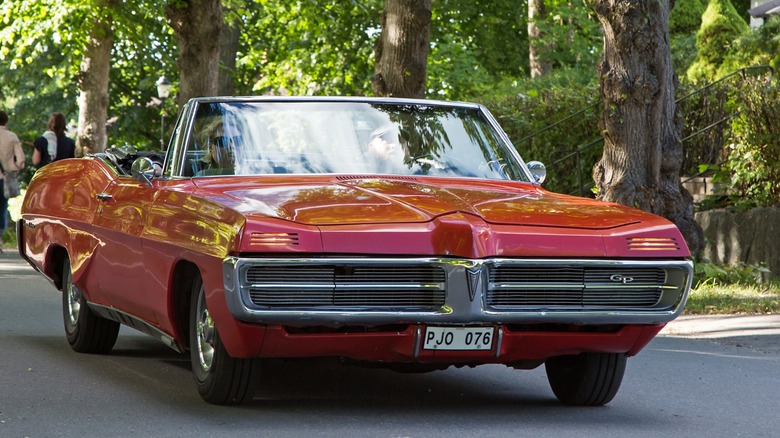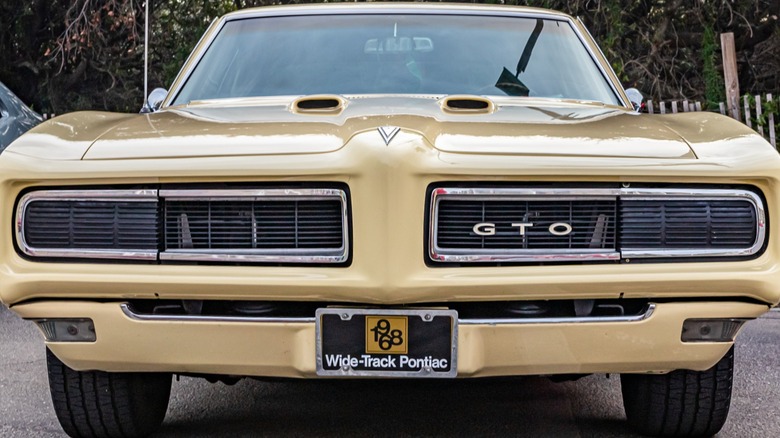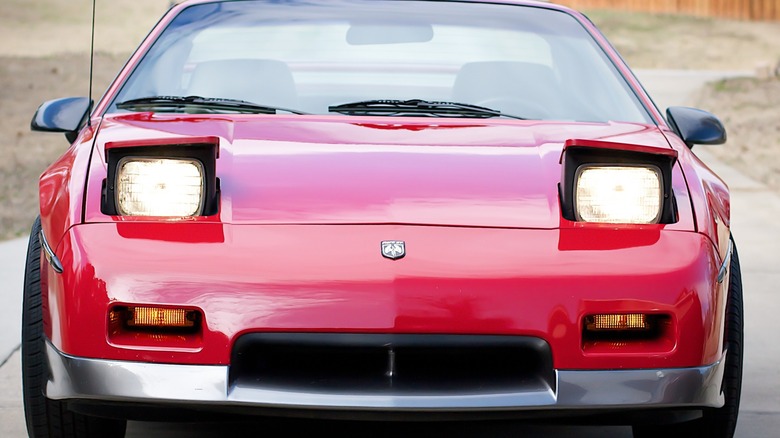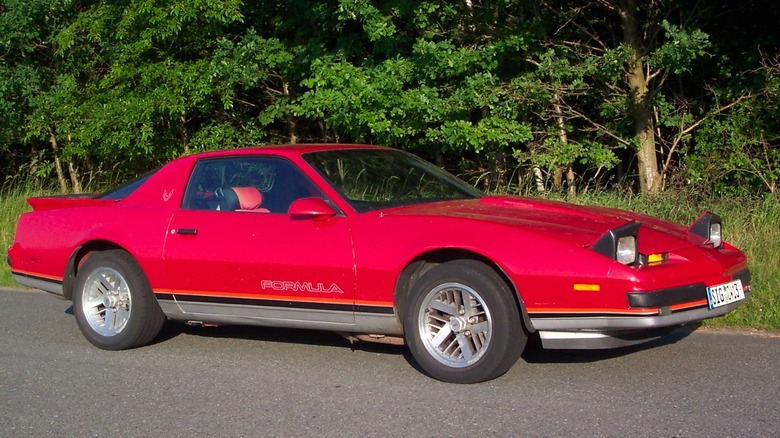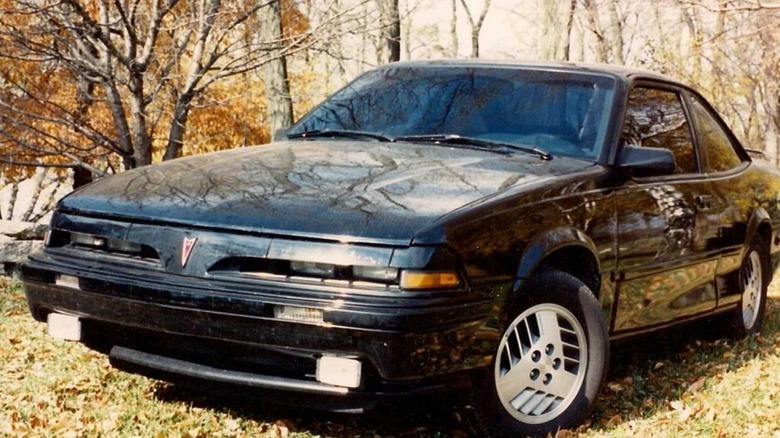Every Pontiac Car With Pop-Up Headlights
Pop-up or hidden headlights are a feature you rarely see on cars anymore. While the sleek headlight design wasn't ever officially banned, new cars don't have pop-up headlights because the feature makes it difficult to comply with pedestrian safety regulations. Those regulations, in part, aim to reduce protrusions that increase the risk of injury should a person be struck by a motor vehicle, resulting in the sleek front ends common on modern vehicles.
In addition to safety regulations, the mechanics of raising pop-up headlights, or opening hidden doors, from a car's front facia eventually presented problems. Some automakers employed electrical systems for operation, and others used an engine vacuum to actuate the mechanism. However, either type was subject to failure at the most inopportune times with one or both headlights refusing to shine past the car's exterior.
Pontiac produced six models with pop-up or hidden headlights, including various model years of the Grand Prix, GTO, Fiero, Sunbird, Firebird, and Tojan, a rather unique Firebird spin-off. While some models like the Grand Prix and GTO among the coolest Pontiac muscle cars, others came later and were met with various levels of adoration.
[Featured image by Kahvilokki via Wikimedia Commons | Cropped and scaled | CC BY-SA 4.0]
The 1967 Pontiac Grand Prix was an early adopter of hidden headlights
The late 1960s were some of the best years for the Pontiac Grand Prix, including the 1967 and 1968 model years featuring hidden headlights. The hidden headlights on these Pontiac Grand Prix models didn't pop up from the top-side of the car's front end. Instead, they remained hidden behind doors until the headlights were turned on. The doors themselves relied on vacuum actuators operating the mechanisms to open and close them.
Ideally the doors would raise and lower seamlessly when the driver switched the headlights on and off. However, cracked rubber vacuum lines, faulty actuator seals, or malfunctioning mechanisms often resulted in one or both doors operating erratically.
These late 1960s Pontiac Grand Prix were large cars, upwards of 4,200 pounds curb weight, and featured V8 engine power. The 400 cubic-inch V8, the base engine offering, provided 265 horsepower with options for higher output versions up to 350 hp. The top engine offering was a 428 cubic-inch V8 with 390 horsepower.
The Pontiac GTO had hideaway headlights in 1968 and 1969
The 1968 Pontiac GTO Ram Air II is among the rarest Pontiac muscle cars due to only 246 units being produced. Its rarity isn't a function of low demand, it's because Pontiac only offered Ram Air II option late in the 1968 model year, following the initial Ram Air package, and then upgraded the offering to the Ram Air III for 1969.
The 1968 Pontiac GTO featured 400-cubic-inch V8 power underrated at 350 hp according to MotorTrend. The publication named the 1968 GTO "Car of the Year," proclaiming it "an excellent handling and performing supercar package" in its February 1968 issue.
Pontiac introduced the GTO Judge for 1969 with much success. The Judge enjoyed a production run of 6,833 coupes and another 108 convertible models. For comparison, the redesigned 1970 GTO sold fewer than 3,800 cars. Another cool fact about the 1968 and 1969 Pontiac GTOs is that they were the last Pontiacs to offer hidden headlights for more than a decade.
The Pontiac Fiero, mid-engine marvel or fiery flop?
You might not know the Pontiac Fiero was the first of its kind among American automakers with its mid-engine, rear-wheel-drive layout. It also featured Pontiac's first pop-up headlight design. While it wasn't exactly a supercar with its introductory 92-horsepower 2.5-liter four-cylinder engine or the 140-horsepower 2.8-liter V6 option available beginning in 1985, it beat the Chevrolet Corvette to the mid-engine class by 36 years.
Winning the race to mid-engine design might be the only category where Fiero owns the Corvette, unless starting campfires is a category you keep track of. It makes one wonder if the Pontiac Fiero's winged-horse badge was an adaptation of the Ferrari horse or an interpretation of a Phoenix, the mythical bird that rises from its ashes?
The 1984 Pontiac Fiero was the leading culprit, catching fire at a rate of about one of every 400 cars produced that year. The fires started from a lack of oil, failed connecting rods, and melted electrical wires placed near the exhaust manifolds. The oil deficiency and wire harness location issues were a result of cramming the inline four-cylinder into an engine bay behind the Fiero's seats. The connecting rod failures were likely due to poor quality materials.
The Firebird, Pontiac's longest lived muscle car
Among the four generations of the Pontiac Firebird, the third- and fourth-gen Firebirds, produced from 1982 to 1992 and 1993 to 2002 may be the least desirable among collectors, but they had the coolest pop-up headlights. Sure, a first-gen Firebird (1967 to 1969) is a beautiful machine, and the second-gen (1970 to 1982) included one of the most famous movie cars of all time in its Trans Am trim, but the third-generation had Kitt, the car from Knight Rider, and the fourth-generation brought back the convertible model option.
Hot Rod magazine called the 1982 Pontiac Trans Am the "best handling Firebird ever," in its January 1982 issue, according to MotorTrend. The base Firebird power plant was a 90-hp four-cylinder. S/E trims came with a 2.8-liter V6 and an option for a four-barrel carburetor fed 5.0-liter V8 with 145 hp. The Trans Am featured the 5.0-liter four-barrel V8 as its standard engine, but the T/A exclusive dual Throttle Body Injection (TBI) option delivered better performance with 165 horsepower.
By the end of the Pontiac Firebird's production in 2002, engine offerings ranged from the base 3.8-liter V6 with 200 horsepower to the Trans Am's 310-hp 5.7L V8. If that's not enough to fulfill your needs, Car and Driver shared the tale of a GMMG-modified 680-hp 454-cubic-inch 2002 Pontiac Firebird Trans Am for sale earlier this year.
[Featured image by CWeitzer via Wikimedia Commons | Cropped and scaled | CC BY-SA 2.0 Germany]
What is a Pontiac Tojan?
In the mid 1980s Pontiac partnered with Knudsen Automotive to create a third-gen-Firebird-based prototype that would prove the automaker was serious about its "We build excitement" motto. Car and Driver says the result was an 800-horsepower twin-turbocharged V8 capable of pushing the Tojan prototype to a 206-mph top speed. In addition to its massive horsepower, the Tojan featured a sleek exterior inspired by the renderings of Hot Wheels designer Harry Bradley.
In reality, the production-model Tojan, built from 1982 to 1991, was less impressive due to the 205-hp 5.7-liter V8 as its top engine option (rumors of forced air inducted production models cannot be confirmed). However, it offered European styling, WS6 suspension, limited slip rear differential, and four-wheel disc brakes. While the interior had some hard plastic trim pieces, there were some premium (for the time) touches like Recaro bucket seats, air-conditioning, cruise control, and a subwoofer to deliver more base from the AM/FM stereo. Like the third-gen Firebird it was based on, the Tojan had pop-up headlights.
Some models of the Pontiac Sunbird had hidden headlights
The Pontiac Sunbird and Firebird share similar names, but that's about the only thing they have in common besides the Pontiac badge and being models sporting hidden headlights. The Sunbird's hideaway headlight feature was limited to GT trims from 1986 to 1993 and in some models the headlights were more squinty than fully hidden.
Among the various engine options installed in the Pontiac Sunbird GT over the years, the turbocharged 2.0-liter four-cylinder offers the most power with 165 hp and 175 lb-ft of torque on tap. The 1990 Sunbird GT, for example, featured a Garrett T25 turbocharger delivering nine pounds of boost pressure while accelerating at wide-open throttle (WOT).
The Pontiac Sunbird was built on General Motors' J-car platform and weighed 2,674 pounds. However, even with its low weight, compared to a 1990 Trans Am weighing 3,510 pounds with a 235-hp 5.7L V8 it's clearly outmatched in any test of acceleration.
As evidence, MotorTrend tested the 1990 Sunbird GT and found the five-speed manual version went from zero to 60 mph in just over seven seconds and completed the standing quarter mile in the mid15-second range at 90 mph. The automatic transmission equipped Sunbird GT accelerated from zero to 60 mph in just under eight seconds, while quarter mile times drifted into the "high 15s to low 16s" seconds range, crossing the stripe at speeds around 85 mph.
[Featured image by Tony Slosarvia Wikimedia Commons | Cropped and scaled | Public Domain]
